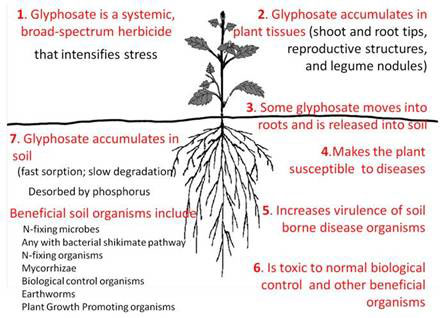
USDA Scientist Reveals All
Glyphosate Hazards to Crops, Soils, Animals, and Consumers
Don Huber painted a devastating picture of glyphosate and GM crops at UK Parliament Dr Eva Sirinathsinghji
In less than an hour, Don Huber, professor emeritus at Purdue University and USDA senior scientist (see Box) delivered to the UK Houses of Parliament a damning indictment of glyphosate agriculture as a most serious threat to the environment, livestock, and human health [1].
Don Huber
Don Huber, Emeritus Professor at Purdue University and senior scientist on USDA’s National Plant Disease Recovery System, has been a plant physiologist and pathologist for over 40 years. His academic career began with 8 years as a cereal pathologist at the University of Idaho, and the next 35 years at Purdue University where he specialised in soil-borne disease control, physiology of disease, and microbial ecology. For the past 20 years, he has conducted extensive research into the effects of glyphosate on crops, in response to the increase in crop diseases on glyphosate-applied fields.
Since his letter to the US Secretary of State Tom Vilsak was leaked in February 2011, there has been a great deal of controversy over what Huber described as a pathogen “new to science” and abundant in glyphosate-tolerant GM crops (see [2] Emergency! Pathogen New to Science Found in Roundup Ready GM Crops?, SiS 50). As he concluded in the letter: “We are now seeing an unprecedented trend of increasing plant and animal diseases and disorders. This pathogen may be instrumental to understanding and solving this problem”.
His talk linked glyphosate to reduced nutrient availability in plants, increasing plant diseases, the emergence of a new pathogen, animal illness and possible effects on human health (see [3, 4] Glyphosate Tolerant Crops Bring Death and Disease, Scientists Reveal Glyphosate Poisons Crops and Soil, SiS 47).
Pathogen new to science
The conversion of US agriculture to monochemical herbicide practice has resulted in the extensive use of glyphosate herbicides. Coincidentally, farmers have been witnessing deterioration in the health of corn, soybean, wheat and other crops, and epidemics of diseases in small grain crops. All are associated with the extensive use of glyphosate, which has increased further since the introduction of glyphosate-tolerant, Roundup Ready (RR) crops.
Glyphosate immobilises nutrients required to maintain plant health and resistance to disease. This weakening of the plants defence could explain the infestation of GM crops with the new pathogen, which has now been observed in horse, sheep, pigs, cows, chicken, multiple animal tissues including reproductive parts (semen, amniotic fluid), manure, soil, eggs, milk, as well as the common fungal pathogen that is currently infesting RR crops, Fusarium solani fsp glycines mycelium. All are coming into contact with glyphosate either through direct exposure or consumption through animal feed. It is also highly abundant in crops suffering from plant Goss’ wilt and sudden death syndrome.
The pathogen can be cultured in the lab, and has been isolated from livestock foetal tissue, replicated in the lab and re-introduced back into the animals. It appears to be very common and may well be interacting with the effects of glyphosate on both plants and animals, exacerbating disease and causing reproductive failure in livestock (see below). Although great expectations have been placed on Huber to publish his findings, he insists that before this can be done, further resources are necessary to be able to characterise the ‘entity’ and identify what type of species it is, including sequencing of its genome. This is a slow process and once complete, it is his intention to publish the work in a peer-reviewed journal.
Understanding glyphosate’s mode of action
Recognising glyphosate’s mechanism of action is the key to understanding how it may exert detrimental effects on the health of crops, animals, and the environment alike. Glyphosate is a broad-spectrum herbicide that interacts with a range of physiological processes in the plant and its environment. Although it is most commonly recognised to work through inhibition of the plant enzyme 5-enolpyruvylshikimate-3-phosphate synthase (EPSPS) involved in the production of aromatic amino acids in the shikimate pathway, it was actually first patented as a strong metal-chelator that binds to metals including manganese, magnesium, iron, nickel, zinc and calcium, many of which are important micronutrients acting as co-factors for plant enzymes in different physiological processes including the plants’ defence system. Indeed, it is actually through chelation of manganese that the EPSPS enzyme is inhibited.
Rendering plants more susceptible to disease through glyphosate’s pathogenic activity is actually the way it exerts its herbicidal activity. This is done not just through immobilising nutrients in the plant but also impacting the agricultural system as a whole. Consistently, if glyphosate does not reach the root of a plant or the plant is grown in a sterile soil, the plant is not killed.
Once in the soil, glyphosate is later immobilised through the chelation of cations, and is therefore very stable and not easily degraded. However, phosphorus (including phosphorus fertilisers) can desorb the herbicide, making it active once again in the soil.
Glyphosate interferes negatively with many components of agriculture
Huber stressed that agriculture is an integrated system of many interacting components, which together determine crop health and therefore yield. This concept is undervalued, and the sooner this is recognised, the sooner we will be able to reap the full genetic potential of our crops.
The three main components of an agricultural system are 1) the biotic environment including beneficial organisms for example, nitrogen-fixing microbes and mineralizers; 2) the abiotic environment including nutrients, moisture, pH; and 3), defence against pathogens that damage crops. The genetic potential of a plant can be achieved by minimising the stress placed on these components through improving plant nutrition and physiology and prevention of diseases and pests.
We have been repeatedly told that to meet the world’s needs for food production we must resort to GM crops and chemical agriculture. However, glyphosate detrimentally interacts with all the agricultural components, so much so that an estimated 50 percent of the potential crop yields are currently being lost (see Figure 1).

Figure 1 Interactions of glyphosate with plant and soil biology; adapted from Huber’s presentation
As shown in figure 1, glyphosate interacts with a wide range of health determinants, which intensifies stress and reduces crop yields. Not only does it accumulate in the plant tissues (shoot and root tips, reproductive structures and legume nodules), it accumulates in the roots where it then leaks into the soil and harms beneficial microorganisms in the soil including those that act as biological controls of pathogens. The obvious consequence is the increased virulence of soil-borne pathogens that lead to disease.
Glyphosate immobilises nutrients critical for plant defence system and other functions
One of Huber’s important discoveries was the close correlation of all the known conditions affecting the disease ‘take-all’ with the availability of manganese to the plant and its physiological effect on resistance to this pathogen.
Micronutrients are the activators or inhibitors of many critical physiological functions. Thus, a deficiency or change in availability of these regulatory elements can greatly affect plant growth and resistance to diseases and pests. Those metabolic pathways producing secondary anti-microbial compounds, pathogen-inhibiting amino acids and peptides, hormones involved in cicatrisation (walling off pathogens), callusing, and disease escape mechanisms can all be compromised by glyphosate.
Micronutrients are also necessary for other processes in a plant. Manganese for example is not only involved in co-activating the EPSPS enzyme, with up to 25 other enzymes known to be affected by manganese chelation. Such enzymes are necessary for photosynthesis, in assimilating carbon dioxide in the electron transport chain, along with zinc. It also helps in the synthesis of chlorophyll and in nitrate assimilation. Numerous enzymes requiring other mineral co-factors are also affected, among them enzymes of the shikimate pathway, to which EPSPS belongs, are responsible for plant responses to stress and the synthesis of defence molecules against pathogens, such as amino acids, lignins, hormones, phytoalexins, flavenoids and phenols.
Consistent with what is known about the role of micronutrients and glyphosate, the levels of key minerals have been measured in transgenic RR soybeans and found to be lower than those in isogenic non-transgenic varieties. Manganese was reduced by as much as 45 %, while iron was reduced by 49 % [5]. Similar deficiencies in mineral content have been found in non-GM varieties, suggesting that the glyphosate, and not the RR transgene, is responsible for reducing mineral availability [6]. Glyphosate reduces photosynthesis, water uptake, amino acid production as well as lignin, a molecule conferring mechanical strength of the plant and crucial for conducting water through plant stems [7, 8].
As Huber stated, the consequences of these nutrient deficiencies is that “crops don‘t look as good, are not as productive or rigorous, and are slower growing“ (see Figure 2). He noted yield drags of 26 % for RR soybeans. Furthermore, with current concerns for global warming, plants that are up to 50 % less water-efficient, such as RR crops, are counter-productive and can only exacerbate problems.
Huber stressed that there is nothing in the glyphosate tolerant crops that operates on the glyphosate applied to them. Consequently, although they have enough resistance to prevent them from dying (conferred by the EPSPS transgene), their overall physiological function is compromised by glyphosate. It therefore affects GM as well as non-GM crops through residual levels of glyphosate in the ground.
In addition to chelating nutrients in the plants, glyphosate can lower mineral content through damaging beneficial soil organisms, including microbes producing indole-acetic acid (a growth-promoting auxin), earthworms, mycorrhizae associations, phosphorus & zinc uptake, microbes such as Pseudomonads, Bacillus that convert insoluble soil oxides to plant-available forms of manganese and iron, nitrogen-fixing bacteria Bradyrhizobium, Rhizobium, and organisms involved in the biological control of soil-borne diseases that reduce root uptake of nutrients.

Figure 2 Effects of long-term glyphosate on crop health; adapted from Huber’s presentation
Glyphosate increases incidence and virulence of soil-borne pathogens
Thirty-four diseases have been reported in the scientific literature to increase in incidence as a result of glyphosate weed-eradication programmes. They affect a wide variety of crops from cereals to bananas, tomatoes, soybean, cotton, canola, melon and grapes [9]. Some of these diseases are considered ‘emerging’ or ‘re-emerging’ as they had not caused serious economic losses in the past. This has worrying implications for the agricultural sector with the US now in its fourth year of epidemics of Goss’ wilt and sudden death syndrome and eighteenth year of epidemic of Fusarium fungal colonisation resulting in root rot and Fusarium wilt. Not only does glyphosate affect disease susceptibility, there is also evidence of increased disease severity. Examples include ‘take-all’; Corynespora root rot in soybean; Fusarium spp diseases, including those caused by Fusarium species that are ordinarily non-pathogenic. Head-scab caused by Fusarium spp of cereals increases following glyphosate application, which is also now prevalent in cooler climates when previously it was limited to warmer climates.
Food and Feed Safety Concerns
Nutrient-deficient, transgenic plants suffering from disease that also harbour herbicide residues, presents an array of possible safety hazards to animals and humans. According to Huber, possible harm include direct toxicity of glyphosate itself, which has been shown to cause endocrine disruption, DNA damage, reproductive and developmental toxicities, neurotoxicity, cancer, and birth defects (see [10]Glyphosate Toxic and Roundup Worse,SiS26; [11]Death by Multiple Poisoning, Glyphosate and Roundup,SiS42; [12]Ban Glyphosate HerbicideNow.SiS43; [13]Lab Study Establishes Glyphosate Link to Birth Defects,SiS48). Furthermore, allergies are on the rise, and animals are showing allergy responses, including inflamed irritated stomachs (Figure 3), discoloration of stomach lining, leakage of intestines as well as behavioural symptoms of irritability and anti-social behaviour in cows (abnormal for herd animals). Inflammatory bowel disease in humans has risen 40 percent since 1992, which may be related to consumption of GM foods, although this has not yet been proven.

Figure 3 Stomach shows allergic response of discolouration and inflammation in GMO fed pig (right) compared with control (left)
The increase in infestation of crops with fungal pathogens that produce toxins is an added concern. Mycotoxins, including fusarium toxins as well as aflatoxins released by Aspergillus fungi are carcinogenic and have forced imports of wheat into the US due to unsafe levels found in domestic harvests.
Triple whammy of reproductive toxicity caused by glyphosate
In 2002, the Cattlemen’s Association gave a statement to US Congress on the serious and puzzling rises in reproductive problems. It said: “high numbers of foetuses are aborting for no apparent reason. Other farmers successfully raise what look to be normal young cattle, only to learn when the animals are butchered that their carcasses appear old and, therefore, less valuable...The sporadic problem is so bad both in the United States and abroad that in some herds around 40-50 percent of pregnancies are being lost.. [and] the viability of this important industry is threatened.”
Glyphosate appears to be able to induce reproductive failures through three separate mechanisms. The first, mentioned above is the endocrine dysfunction caused by direct toxicity of glyphosate.
The second is the reduced nutrient content having consequential effects on the nutritional status of animals. Manganese in animals, as in plants, is an essential nutrient, and deficiencies have been associated with a variety of diseases as well as reproductive failures, which are becoming increasingly common in livestock. One study performed in Australia following two seasons of high levels of stillbirths in cattle found that all dead calves were manganese deficient [14]. Furthermore, 63 percent of babies with birth defects were also deficient. Manganese is known to be important for mobilising calcium into bones, correlating with abnormal bone formation in these calves.
Third, the unknown pathogenic ‘entity’ may be associated with inducing pseudo-pregnancies. As far back as 1998, a suspect agent was found in reproductive tissue of livestock. It has now been isolated in high concentrations from semen, amniotic fluid as well as placental tissue. It has also been found in aborted foetal tissue. Some farms are reporting up to 50 percent fewer conceptions in animals due to increased miscarriages and pseudo-pregnancies. Although evidence of the widespread presence of this new pathogen is clear, Don Huber suggested the need for further research to understand not only what kind of pathogen it is, but importantly, the effects it is having on the health of plants as well as animals.
To conclude
Over 100 peer reviewed papers have been published by Huber and other scientists on the detrimental effects of glyphosate. Glyphosate increases disease in plants (as well as animals), prompting Huber to write to the Secretary of Agriculture. It may be linked to many health problems in animals and humans, which are an added cost to all the failed promises of a new agricultural technology that would feed the world. As Huber concluded, the “public trust has been betrayed.”
Article first published 09/01/12
References
All-Party Parliamentary Group on Agroecology Meeting, Huber DM “The effects of glyphosate (Roundup®) on soils, crops and consumers: new diseases in GM corn and soy and animals fed with it”, 20 November 2011, Houses of Parliament, UK.
http://agroecologygroup.org.uk/index...gs/2011-11-01/
Ho MW. Emergency! Pathogen new to science found in Roundup Ready GM crops? Science and Society 50, 10-11, 2011.
Ho MW. Glyphosate Tolerant Crops Bring Death and Disease. Science in Society 47, 2010, 12-15
Ho MW. Scientists Reveal Glyphosate Poisons Crops and Soil. Science in Society 47, 2010, 12-15
Zobiole LHS, Oliveira RS Jr, Huber DM, Constantina J, Castro C, Oliveira FA, Oliveira A. Jr. Glyphosate reduces shoot concentrations of mineral nutrients in glyphosate-resistant soybeans. Plant Soil 2010, 328:57-69
Cakmak, I, Yazici, A, Tutus, Y, and Ozturk L. Glyphosate reduced seed and leaf concentrations of calcium, magnesium, manganese, and iron in non-glyphosate resistant soybean. European Journal of Agronomy 2009, 31, 114-119.
Zobiole LHS, Silvério de Oliveira RS Jr, Kremerb RB, Constantina J, Bonatoc CM, Muniz AS. Water use efficiency and photosynthesis of glyphosate-resistant soybean as affected by glyphosate. Pesticide Biochemistry and Physiology 2010, 97, 182-193
Zobiole LHS, Bonini EA, Oliveira RS Jr, Kremer RJ, and Ferrarese-Filho O. Glyphosate affects lignin content and amino acid production in glyphosate-resistant soybean. Acta Physiologiae Plantarium 2010, 32, 831-837
Johal GS & Huber DM. Glyphosate Effects on Disease and Plants. European Journal of Agronomy 2009, 31, 144-152
Ho MW and Cummins J. Glyphosate toxic and Roundup worseScience in Society 26 2005, 12.
Ho MW and Cherry B. Death by multiple poisoning, glyphosate and Roundup.Science in Society 422009, 14
Ho MW. Ban glyphosate herbicides now.Science in Society 43 2009, 34-35
Ho MW. Lab study establishes glyphosate link to birth defects.Science in Society 48 2010, 32-33
McLaren PJ, Cave JG, Parker EM, Slocombe RF. Chondrodysplastic calves in Northeast Victoria. Veterinary Pathology 2007, 44, 342-54
Got something to say about this page? Comme
How to detox glyphosate (Roundup) from your body
23 Proven Benefits of Glycine Supplements + Glycine Foods








 Reply With Quote
Reply With Quote ers.Mitteilung
ers.Mitteilung harmakologische Grundlagen einer therapeutischen Verwendung von Kohle.Dt
harmakologische Grundlagen einer therapeutischen Verwendung von Kohle.Dt




Bookmarks